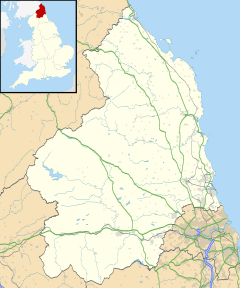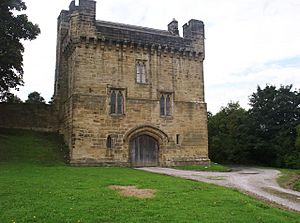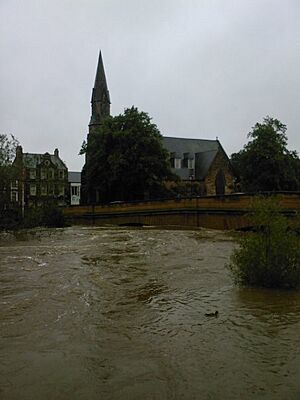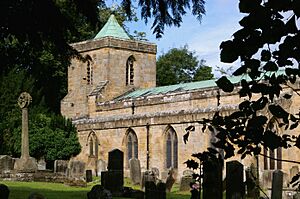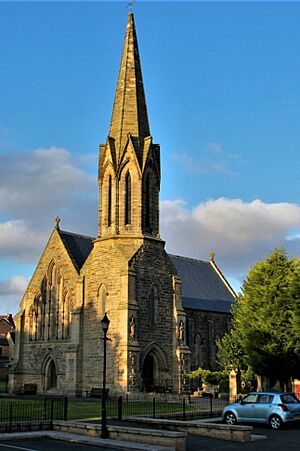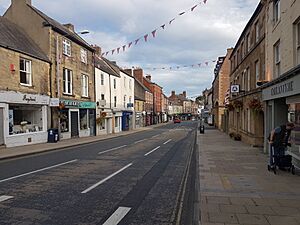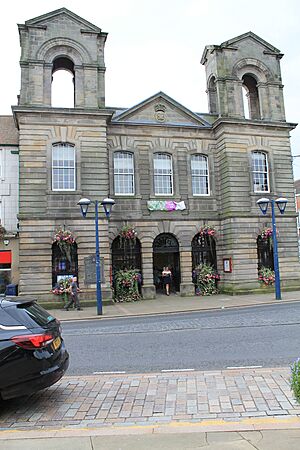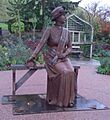Morpeth, Northumberland facts for kids
Quick facts for kids Morpeth |
|
|---|---|
| Town | |
 Clockwise from top: River Wansbeck at Carlisle Park, Morpeth Castle, Morpeth Clock Tower, Morpeth station and Morpeth Chantry |
|
| Population | 14,017 (2011) |
| Language | English |
| OS grid reference | NZ2085 |
| • Edinburgh | 80 mi (130 km) NW |
| • London | 261 mi (420 km) SSE |
| Civil parish |
|
| Unitary authority |
|
| Ceremonial county | |
| Region | |
| Country | England |
| Sovereign state | United Kingdom |
| Post town | MORPETH |
| Postcode district | NE61 |
| Dialling code | 01670 |
| Police | Northumbria |
| Fire | Northumberland |
| Ambulance | North East |
| EU Parliament | North East England |
| UK Parliament |
|
Morpeth is a historic market town in Northumberland, England. It is located on the River Wansbeck. Nearby towns include Ashington and Bedlington. In 2011, about 14,017 people lived in Morpeth.
People have lived in the area since the Neolithic period (New Stone Age). Some Roman artifacts have also been found. The town was first mentioned in writing around 1080. This was when the de Merlay family was given control of the Morpeth area. The name "Morpeth" might mean "murder path," possibly because of a murder on the road to Scotland.
The de Merlay family built two castles in Morpeth. One was built in the late 11th century and another in the 13th century. Morpeth received its own coat of arms in 1552. It became a major market town in England by the mid-1700s. However, when railways opened in the 1800s, the market became less important. Today, Morpeth's history is celebrated each year at the Northumbrian Gathering.
Morpeth is governed by Northumberland County Council and Morpeth Town Council. The town is divided into three areas called wards for local elections. Morpeth has faced severe floods in 2008 and 2012. This led to the building of new flood defenses. Morpeth railway station is on the main east coast railway line. A sharp curve near the station has caused several train crashes.
Morpeth is home to several sports teams. Morpeth Town A.F.C. won the FA Vase football competition in 2016. The town even hosted its own Olympics from 1873 to 1958. Morpeth has schools for different age groups and several churches. Carlisle Park in Morpeth has won awards and features one of England's four floral clocks.
Contents
- Morpeth's Past: A Look at its History
- How Morpeth is Governed
- Weather and Flooding in Morpeth
- Getting Around: Transport in Morpeth
- Learning in Morpeth: Schools and Education
- Places of Worship in Morpeth
- Sports and Recreation in Morpeth
- Media in Morpeth
- Famous Places in Morpeth
- Famous People from Morpeth
- Images for kids
- See also
Morpeth's Past: A Look at its History
Morpeth was founded where people could cross the River Wansbeck. Very few ancient remains have been found. However, a stone axe from the New Stone Age shows people lived here early on. There is not much proof of activity during the Roman occupation. But it is likely there were settlements in the area.
The first written record of Morpeth is from 1080. This is when William de Merlay was given the "Barony of Morthpeth." This land stretched from the River Tyne to the River Coquet. The name "Morpeth" comes from Old English words meaning "murder path." An old writer in 1666 said this name came from "many robberies and murders" that happened there.
Castles and Markets: How Morpeth Grew
The de Merlay family received the Morpeth area around 1080. By 1095, William de Merlay had built a motte-and-bailey castle. It is not clear if there was a town at Morpeth when the land was first given to the family. Documents from 1137 mention the "new town of Morpeth."
Newminster Abbey was founded in 1138 by Ranulf de Merlay, the lord of Morpeth. It was one of the first daughter houses of Fountains Abbey. In 1200, King John gave Morpeth the right to hold a market. By the mid-1700s, Morpeth was one of the main markets in Northern England. It was especially known for selling cattle brought from Scotland. However, when railways opened in the 1800s, it became easier to transport goods to Newcastle. This caused Morpeth's market to become less important. The market is still held every Wednesday.
In 1215, the town was badly damaged by a fire. This fire was set by barons during a war to stop King John's army. The old motte-and-bailey castle was likely burned down. A new Morpeth Castle was built later in the 13th century. The only parts of the castle left today are the inner gatehouse and some ruined walls. The gatehouse has been restored and is now used for holidays.
In the 13th century, a stone bridge was built over the Wansbeck River. This bridge replaced an older crossing point. In 1515–16, Margaret Tudor, the sister of King Henry VIII, stayed ill at Morpeth Castle for several months.
Morpeth's Coat of Arms and Later Years
In 1540, a royal writer named John Leland described Morpeth as "long and fairly well-built, with low houses." He also said it was "a far fairer town than Alnwick". In 1552, Morpeth was given its coat of arms. The design was similar to the de Merlay family's arms, but with a gold tower added. This was to remember the family's kindness to the town.
Morpeth had a local government system for a long time. It received its first official charter from King Charles II. This charter created a local government controlled by seven trade groups. This system lasted until 1835. During the Second World War, RAF Morpeth was an air-gunnery training school nearby.
The town's history and culture are celebrated each year at the Northumbrian Gathering. This event takes place over a weekend in mid-April. The 50th gathering was held in 2017.
How Morpeth is Governed
Morpeth has two levels of local government.
Morpeth Town Council
The first level is Morpeth Town Council, which has 15 members. Morpeth is a civil parish and has the status of a town. For local elections, the town is divided into three areas called wards: North, Kirkhill, and Stobhill. Each ward elects five town councillors. Each ward also elects one County Councillor. In May 2021, the Town Council had ten Conservative members, two Liberal Democrats, two Green members, and one Labour member.
Northumberland County Council
The second level of local government is Northumberland County Council. This council meets at County Hall in Morpeth. Since 2009, the county council has been a unitary authority. This means it handles all local government services. Before 2009, there was another level of government called Castle Morpeth. This district has now been removed. The county council has 67 councillors. Three of these represent Morpeth, one from each ward. In the 2017 and 2021 elections, all three Morpeth wards elected Conservative councillors.
Weather and Flooding in Morpeth
A weather station has been in Cockle Park, just north of Morpeth, since 1897.
Floods of 2008 and 2012
On September 6, 2008, Morpeth experienced a very bad flood. About 1,000 properties were damaged, and 400 people had to leave their homes. The town's flood defenses failed after a month's worth of rain fell in just 12 hours.
In September 2012, flooding happened again. Properties were damaged, but the water was about 3 feet (1 meter) shallower than in 2008.
Building Flood Defenses
Work on new flood defenses began in 2013 because of the 2008 floods. New defenses were built in the town center. A dam with a storage area was also built on the Mitford Estate. A second dam, costing £27 million, was finished in May 2017. This dam helps reduce flooding from the Cotting Burn. Its completion marked the end of the Morpeth flood defense plan.
Getting Around: Transport in Morpeth
Roads in Morpeth
The A1, which is the longest numbered road in the UK, used to go through Morpeth. However, a bypass was opened in 1970, so it now goes around the town. Other important roads that pass through Morpeth include the A192, A196, and A197.
Morpeth Northern Bypass
The Morpeth Northern Bypass was built to reduce traffic in the town center. It also helps people travel faster from nearby towns like Pegswood and Ashington to the A1. The bypass connects to the Pegswood Bypass and continues to several roundabouts. This project was finished in 2017. It has made it easier to travel to and from southeast Northumberland.
Trains and Buses
Morpeth's railway station is on the main East Coast Main Line. This line runs between London and Edinburgh. South of the station, there is a sharp curve. This curve has been the site of several train crashes. A railway line that does not carry passengers runs between Morpeth and Bedlington. An older line, which closed in 1966, used to run west from Morpeth.
Arriva North East is the main bus company in Morpeth. Buses go to nearby towns and villages like Pegswood and Ashington. They also go to larger cities like Newcastle and Alnwick.
Learning in Morpeth: Schools and Education
The main state school in Morpeth is King Edward VI School. It started as a church school in the early 14th century. This school was located in the Morpeth Chantry. In 1552, it was officially re-established as the Free Grammar School of King Edward the Sixth. Locals often called it Morpeth Grammar School. In the 1970s, it became a comprehensive school, which means it takes students of all abilities.
Morpeth has two middle schools, Newminster and Chantry, which are next to each other. There are also several first schools for younger children. These include Abbeyfields First School, Morpeth First School, and Stobhillgate First School. Morpeth All Saints' Church of England-aided First School is also in the town. For Roman Catholic children, St. Robert's R.C. First School is located in Oldgate.
Places of Worship in Morpeth
Church of England Churches
The oldest Church of England church in Morpeth is St Mary's at High Church. This was the main Anglican church until the 1840s. Most of the church was built in the 14th century. The grave of Emily Wilding Davison, a famous suffragette, is in St Mary's graveyard.
In 1843, people decided to build a new church in the town center. This was because the walk to St Mary's was too far for many people. The new church, St James the Great, was opened on October 15, 1846. It was designed in a "Neo-Norman" style, similar to a 12th-century cathedral in Sicily.
A third church, St Aidan's, was started in 1957. It is located on the Stobhill estate.
Roman Catholic Church
Morpeth's Roman Catholic Church, St Robert of Newminster Church, was built near Admiral Lord Collingwood's house. It was officially opened on August 1, 1850. Collingwood House is now where the priest lives.
Other Churches
Morpeth has had a Presbyterian church since 1693. Their first service was in a tannery loft. In 1721, a chapel was built. The current St. George's United Reformed Church was started in 1858 and opened in 1860. It stands near the Telford Bridge.
The current Methodist Church in Howard Terrace opened in 1905. It was built from local stone. Although different Methodist groups joined together in 1932, a separate Wesleyan Church continued until 1964. Then, all Methodists in Morpeth began worshipping at Howard Terrace. The old Wesleyan Church is now used by the Explorer Scouts.
Sports and Recreation in Morpeth
Morpeth Town A.F.C. (football), Morpeth RFC (rugby), and the Morpeth Golf Club all play competitively in Morpeth. The Morpeth Harriers compete in athletics. The town also offers many ways to play sports for fun. These include Carlisle Park, a common area for golf and football, and the Riverside leisure center for swimming and indoor sports. Morpeth Town A.F.C. won the FA Vase in 2016.
The Morpeth Olympic Games were held from 1873 to 1958. These were professional events, mainly featuring athletics and wrestling. They stopped during the two world wars. The games were held at different fields around the town over the years.
In 1730, a horse racing track was built. It was used until 1854, when St. George's Hospital was built in its place.
Morpeth was also the starting point of the Morpeth To Newcastle Road Race. This running race was held every New Year's Day from 1902 to 2004. It stopped because of high costs for insurance and policing. Famous winners included Olympic medalist Mike McLeod.
Media in Morpeth
Local news and TV shows for Morpeth are provided by BBC North East and Cumbria and ITV Tyne Tees. TV signals come from the Pontop Pike and local relay transmitters.
Local radio stations include BBC Radio Newcastle (95.4 FM), Capital North East (105.3 FM), and Heart North East (101.8 FM). There is also Koast Radio, a community radio station on 106.6 FM.
The Morpeth Herald is the town's local weekly newspaper.
Famous Places in Morpeth
The center of Morpeth used to be made up of Bridge Street, Oldgate Street, and Newgate Street. Small plots of land called burgage plots led off these streets. You can still see parts of this old layout today. For example, Old Bakehouse Yard is a former burgage plot. The town is directly on what used to be the Great North Road. This was the old route for coaches between London and Edinburgh.
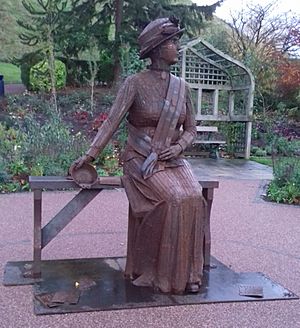
Carlisle Park is on the south bank of the River Wansbeck. The park has the William Turner Garden. It also features one of only four floral clocks in England. There is a statue of Emily Wilding Davison in the park. Morpeth's Mafeking Park was suggested by locals as the smallest park in the world.
Other important landmarks in Morpeth include:
- Morpeth Clock Tower, a 17th-century clock tower that stands alone.
- Morpeth Town Hall, originally designed by Sir John Vanbrugh. It was rebuilt in 1869.
- Collingwood House, the home of Admiral Lord Collingwood.
- Morpeth Chantry, a 13th-century chapel. It now holds the town's tourist information center and the Morpeth Chantry Bagpipe Museum.
- Morpeth Castle, which is on a hill to the south. It is now used for holiday accommodation.
- A nuclear bunker located under Morpeth County Hall.
- A gateway on High Stanners made from a whale's jawbone.
- The ruins of Newminster Abbey, a former monastery about one mile west of Morpeth.
- Morpeth Court, which used to be a courthouse and prison. It is now apartments.
Famous People from Morpeth
Many notable people have connections to Morpeth:
- James (Jim) Alder (born 1940), an athlete who grew up in Morpeth.
- Arthur Bigge, 1st Baron Stamfordham (1849–1931), born near Morpeth. He became a private secretary to Queen Victoria and King George V.
- Robert Blakey (1795–1878), a journalist and philosopher born in Morpeth.
- Vice Admiral Cuthbert Collingwood (1748–1810), a famous Royal Navy Admiral. He lived in Morpeth.
- Emily Wilding Davison, a suffragette. After her funeral in London, her coffin was brought to Morpeth for burial in St Mary's churchyard.
- William Elliott, Baron Elliott of Morpeth (1920–2011), a politician born in Morpeth.
- Toby Flood (born 1985), a rugby player for England, who went to school in Morpeth.
- Robert Morrison (1782–1834), who translated the Bible into Chinese. He was born in Morpeth.
- William Turner (naturalist) (c. 1508 – 1568), an English doctor and natural historian. The William Turner Garden in Carlisle Park is named after him.
- Dr. N. T. Wright (born 1948), a theologian and author, born in Morpeth.
Images for kids
See also
 In Spanish: Morpeth para niños
In Spanish: Morpeth para niños


